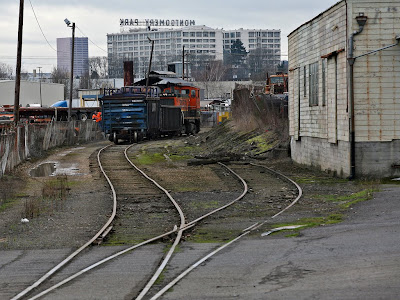 |
| Train time at Whitefish. |
We've been in Montana since long before I woke up this morning, and we still are nine hours later with over 200 miles of Big Sky country to go. Since leaving the eastern boundary of Glacier National Park, we've been rolling through the flat, high prairies that comprise the eastern two-thirds of the state, dubbed “flyover country” in the age of jetliners. Nothing like overland travel to drive home the sheer breadth of this continent.
We were on-time out of Pasco at 9:00 last night, and that looks to be the end of on-time performance for this trip. Train no. 8, the Seattle section, was 2-1/2 hours late into Spokane, so it was almost 3:00 in the morning by the time they put the two sections together, and well after 3:00 when we finally left. (Scheduled departure is 1:30 a.m.) I slept pretty well despite being surrounded by a pack of rowdy skiers going to Montana who were quite disappointed to learn that if they consumed the alcoholic contents of their cooler on the train, they would be kicked off. The staff on this train is based out of Chicago, and due to the blizzard there, they had to spend an extra day on the West Coast, so they're all anxious to get home and in no mood for trouble. They also seem to all be Steeler fans. My car attendant is mad at the Packers for beating “her” Bears, and the lounge car attendant hails from Pittsburgh and proudly hangs a Terrible Towel behind the counter (the official hum-haw Myron Cope version). She's giving free coffee refills since we're running late, so I can be a Steeler fan, too, at least for now. (I'm not even sure if I'll watch the game.)
 |
| The Seattle section of the Empire Builder coupling onto the Portland section at Spokane. |
I stepped out just long enough in Spokane to watch the combination of the Portland and Seattle sections. It was once common for long distance passenger trains to combine and separate en route to provide direct service to multiple cities while achieving greater economies of scale on the overlapping portions of the route. Union Pacific famously (infamously?) ran a streamliner in the 1960s that went by the nickname “City of Everywhere,” as several sections combined, ran together across the middle of the country as a giant, 20+ car train, and then split apart to reach different destinations. In the 21st century, only two of Amtrak's long-distance passenger trains routinely combine and split: the Empire Builder in Spokane and the Lakeshore Limited in Albany, New York.
The skiers left us this morning at Whitefish, Montana, enough of them that the baggage tractor was pulling four trailers piled high back to the station. At Conkelley, we passed two crows and a bald eagle just a few yards from the tracks, showing no fear as they pecked at a carcass in the snow. I'm so used to heroic, patriotic imagery of our national bird that it always comes as a mild shock to see it “reduced” to scavenging. It was a good dose of reality in the quite, almost surrealistic morning, peering out into the snow and down into the ice flows in the Flathead River from the comfort of my padded, climate-controlled coach seat.
We overtook an eastbound container train just out of Whitefish, but we soon stopped again. Host railroad BNSF keeps a window open everyday for Amtrak's schedule, but if the passenger train runs late and misses that window, all bets are off. At Coram siding, we waited 45 minutes for not one, but two westbound loaded grain trains to pass us. I hope they were at least expedited “G9” trains, pressing westward to meet waiting ships in Portland or Tacoma. We then overtook another eastbound container train at West Glacier, by then running almost three hours late.
After stopping in Essex and its historic Isaac Walton Inn, we waited briefly to cross the single-track trestle at Java as a loaded coal train descended from the continental divide at Marias Pass. We stopped again just east of the summit due to high wind warnings, with gusts of up to 69 mph – BNSF will allow Amtrak to proceed at restricted speed with winds up to 65 mph, but nothing above that. I settled in for a long wait, but we were moving again within a few minutes, and I held my breath as we crossed the wide open trestle high above Two Medicine creek near East Glacier. Delays earlier this morning elicited groans and complaints from the vacationing skiers. Since then, the remaining passengers – most of them traveling for necessity or to visit family – have taken the unscheduled stops in stride.
From the windy summit, we've been running well, but still encountering plenty of opposing traffic (including at least five more loaded grain shuttles) on the busy High Line, but for the most part these trains waited for us. The sun appeared and snow remained only in shaded pockets and drifts on much of the high prairies. I didn't even need my jacket when I stepped onto the platform for a brief stop at Shelby. At Havre for the afternoon service stop, the yard was filled with even more grain trains and shadows falling long across the snow. The cloud bank on the eastern horizon has been getting closer and bigger for the past few hours, but it will be dark soon, and I look forward to dinner in the diner and tomorrow's run down the Mississippi valley.












































